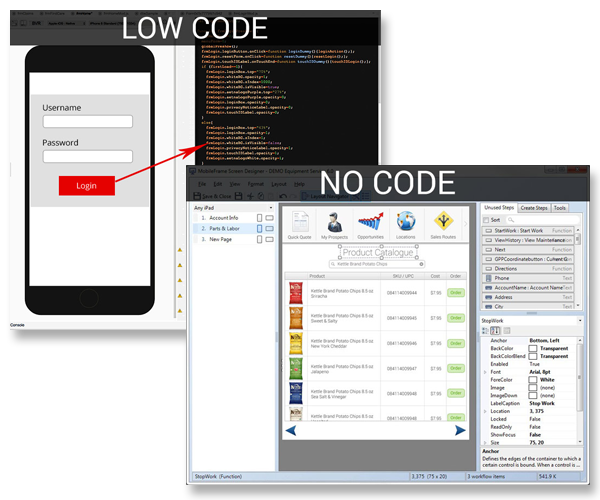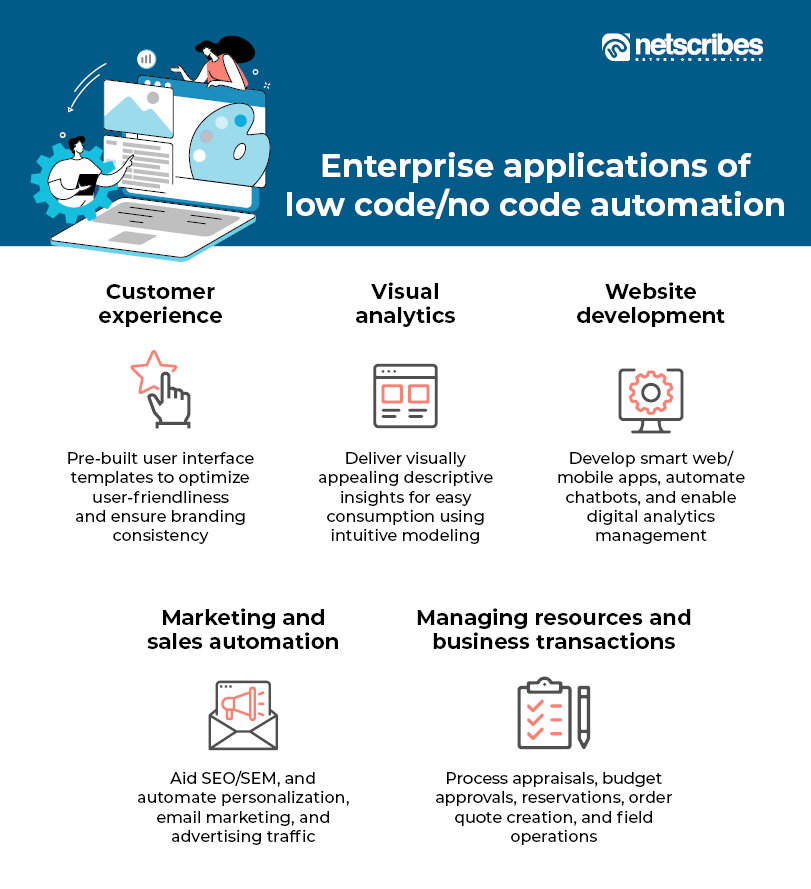Great News To Selecting application development with Low-code platforms
Wiki Article
Advantages Of Low-Code Application Development In Terms Of Speed
Visual Development Environment :
Drag-and-Drop Interfaces: Low-code platforms provide visual tools for designing applications. Drag-and-drop elements allow developers to quickly build applications without the need to write long lines of code.
Pre-built Templates and Components: A lot of low-code platforms have pre-built templates and components, which allow developers to rapidly develop and test applications without starting from starting from scratch.
Reduced Coding Requirements for Coding:
Automated Coding Generation: Low-code platforms generate code automatically using the visual model developed by the developers. This reduces the need for manual code coding and improves the speed of development.
Reusable Components : Developers can reuse components in different projects to reduce the amount of time they spend writing and testing code.
Streamlined Collaboration:
Low-code platform tools often include versions control, testing or deployment. This facilitates seamless collaboration between teams.
Citizen Development Business users, non-developers and other users can all contribute to application creation by using user-friendly interfaces. This reduces the bottleneck caused by inaccessibility of professional developers.
Rapid Iteration, Prototyping:
Rapid prototyping: Developers are able to quickly create prototypes in order to gather feedback and verify ideas, resulting in faster cycles of iteration.
Easy Modifications: The visual nature of low-code development makes it easier to make modifications and updates to applications, which speeds up the process of improving and refining applications based on user feedback.
Pre-built Integrations:
API Integrations. Low-code platform often come with pre-built connectors as well as APIs for the most popular services, which reduces the time needed to integrate other systems.
Data Integration: The instruments that are built into the software simplify and speed up the process of linking databases, other data sources and applications.
Deployment of Scaling:
One-Click-Deployment: Many Low-Code platforms provide one-click option for deployment. This reduces the amount of time and effort required to set up an application.
Cloud-based Platforms: Cloud-based platforms which are low-code can manage infrastructure and scaling, so developers can focus on logic and functionality of applications instead of deployment logistics.
Low-code application development is a quicker method to develop applications. It streamlines and automates various aspects of the process. This allows for quicker development and the ability to adapt to the changing needs. Read the best Low-code Platform for application development tips for more examples including rad development, push notifications android, mobile development platforms, app modernization, software for app development, ms azure sql, develop web application, ms azure sql, rad development, application development platforms and more.

Scalability And Flexibility Are The Two Advantages Of Low-Code Application Development
Low-code development can bring many benefits in regards to scalability and flexibility essential to developing applications that can be capable of growing and adapting to changing business needs. Three benefits are listed below.
Cloud-Based Deployment: Many low-code platforms are cloud-based which allows applications to grow easily with the cloud infrastructure. This allows companies to handle more workloads without having to worry about server management.
Auto-Scaling Features: Built-in auto scaling features automatically adjust resources in accordance with the demand. This provides consistent performance even during peak times, without the need for manual intervention.
Flexible Architecture:
Modular Design: Low code platforms encourage modularization of applications, which allows components to be designed independently and tested, as well as scalable. This flexibility improves flexibility and facilitates upgrades or expansions of certain components without affecting the overall system.
Microservices Integration Support for microservices architecture allows applications to be built as a set of loosely coupled services, enhancing both scalability and flexibility.
Customizable Solution:
Extensibility Low-code systems typically permit custom programming and scripting. This allows developers to expand the functionality of applications beyond the capabilities that are available in the box. This allows the satisfaction of unique business needs without limits.
Third-Party Integrations: Businesses may add additional functionality and features into their apps through APIs and third-party services.
Agile Development Deployment, Agile Development and Agile Development:
Continuous Deployment and Delivery Low-code platforms are able to support agile methodologies, which allow continuous deployment and integration (CI/CD). This enables rapid deployment of updates and new features, ensuring that the applications are able to evolve rapidly in response to feedback from users and market changes.
Iterative development: Low-code development is iterative meaning that applications can be adapted and improved gradually. This decreases the risk of massive changes, while also allowing the growth to be controlled.
Resource Optimization
Low-code platforms can monitor and manage application performance and help to optimize the use of resources. This will ensure that resources are used effectively. They can also be scaled-up or reduced according to actual needs.
Load Balancing: The integrated load balancing features distribute workloads equally across servers, increasing the ability of the application to handle high traffic and ensuring consistent performance.
Global Reach
Multi-Region Deployment: Low-code platforms typically support deployment across several geographical regions, allowing companies to offer low-latency connectivity to users across the globe. This is particularly important for apps that have a large global user base.
Localization Support : Built-in language support lets applications adapt to different languages and regional requirements. This allows them to be more flexible on diverse markets.
Updates and maintenance
Simple Maintenance : Low-code programs are modular and visual. This simplifies maintenance tasks. This allows bugs and updates to be completed quickly and without long periods of downtime.
Version Control Systems for Controlling Versions will help you manage updates, rollbacks and other changes. They can assure that the changes can be released safely and previous version is restored as required.
Cost Efficiency:
Low Development Costs - By decreasing the amount of programming needed, low-code platforms can cut down on the development cost. This allows you to expand applications without needing to increase the development effort and expenditure.
Pay-As.-You-Go Lowcode platforms provide flexible pricing models, such as pay-as.-you-go. These models align prices with usage and growth in order to give financial flexibility.
The majority of low-code application developers offer a high level of scalability and flexibility that allows companies to rapidly build robust and flexible apps. These platforms allow for quick adjustments to changing demands, efficient resource use, and constant improvement, which ensures that applications develop and grow in line with business needs. Follow the recommended Legacy application modernization with Low-code for site info including azure sql databases, application development platforms, rad development, database in azure, develop mobile application, application development platforms, software for app development, push notifications, app modernisation, application modernization software and more.

Advantages Of Low-Code Application Development In Terms Of Vendor Support And Community
Low-code development platforms for applications have significant advantages in terms of the support provided by vendors and communities. These are essential for successful implementation, ongoing maintenance, and continual enhancement of applications. Here are some of the main benefits: Vendor support
Comprehensive Technical Support:
Support Teams Dedicated to You A lot of low-code platforms have dedicated support teams that can help in technical problems, problem-solving and advice. This will ensure that any problems are quickly resolved.
Some vendors offer 24/7 support. This can be very useful for companies that operate across time zones.
Training and Onboarding:
Structured Training: A lot of companies offer structured training, such as tutorials, webinars and certification classes to aid users in becoming comfortable with the platform.
Personalized Onboarding Many vendors offer individualized services to assist their new customers get onboard effectively and customize it to their needs.
Regular updates and improvements:
Continuous Improvement: Low-code platform vendors generally release periodic updates which include the latest features, performance enhancements, and security patches, making sure that their platform is modern and safe.
Feedback integration: Vendors often incorporate user feedback into their process of development to make sure the platform is able to meet the changing requirements of users.
Comprehensive Documentation:
Documentation - In depth: A comprehensive and well-organized document covering everything from basic use to advanced modifications are often accessible. This allows users to solve problems independently.
API References In-depth API documentation lets developers modify applications and connect low-code platforms into other platforms.
Consulting and Professional Services:
Expert Consulting : Vendors provide consultation services such as designing architecture and complex implementations. They do this in order to make sure that their users are able fully benefit from the platform.
Custom Development Services: A few vendors offer custom development services to build specific features or integrations that aren't available in the standard package.
Community Support for the Community
Active User Groups:
Discussion boards and forums A lot of platforms with low-code offer a lively online community that allows users to ask for help, share solutions and collaborate to find the most efficient practices.
Local and virtual user groups as well as Meetups, offer opportunities for users to discuss their experiences, learn from others, and network.
Knowledge Sharing and Collaboration
Community-Contributed Resources: Users often share templates, modules, and extensions that they have developed, which can be reused or adapted by others, accelerating development and innovation.
Crowdsourced Solution Finding: The collective wisdom and experience of a community can be a valuable resource in solving complex issues.
Learning and Development
Community-Led Learning: Several communities host workshops, training sessions, and webinars which are typically directed by experts who can share their knowledge and techniques that are more advanced.
Online Tutorials and Courses Members of the community frequently make online tutorials, classes, and tutorials on how to accomplish things, which enhances learning resources.
Feedback and Influence
Product Feedback Channels. Community forums usually include channels where you can provide feedback to the vendor. The feedback you provide can affect the development and improvement of features.
Beta Testing Programs: Members of the community who are active could be able to participate in beta testing programs, which gives users early access to brand new features and a voice in influencing the evolution of the platform.
Recognition and Support:
Community Recognition Programs: A lot of vendors have recognition programs to honor the efforts of community members who are active for example, MVP (Most Valuable Professional) programs.
Peer Support Community members often offer peer support by sharing their knowledge and offering guidance for those who aren't as experienced. This helps create a more collaborative and supportive atmosphere.
The combination between robust vendor support, and an engaged, active community creates a broad ecosystem of support for development with low-code. The users will benefit from the experience and resources needed to create, deploy and maintain their application.
